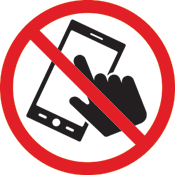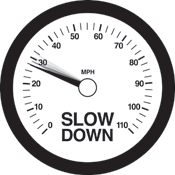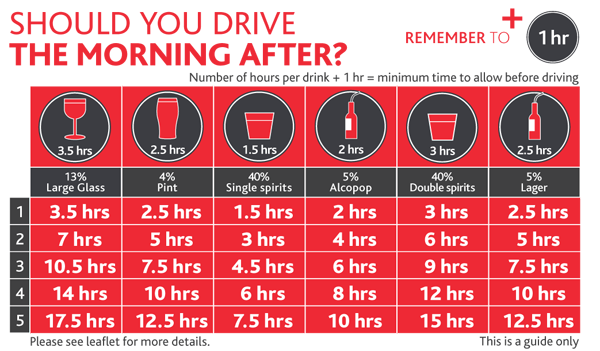It's not worth the risk
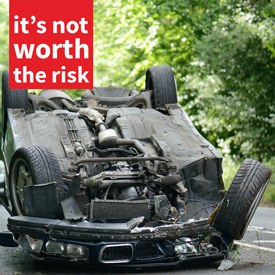 Did you know that over 90% of collisions are due to human error?
Did you know that over 90% of collisions are due to human error?
Or what the biggest dangers whilst driving are?
We continually develop our driving skills no matter how long we’ve been driving for.
Here’s our top tips on how you could avoid the fatal four.
Eyes on the road
Even careful drivers can be distracted, by a phone call, text message, in car technology or a Satnav. A split second lapse of concentration could result in a crash.
It’s your call
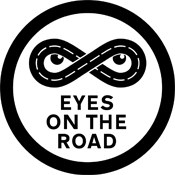 Did you know that using a mobile phone when driving increases the chances of a crash by 4 times?
Did you know that using a mobile phone when driving increases the chances of a crash by 4 times?
- Make your glove compartment your phone compartment.
- Set your phone to do not disturb when you're driving.
- Divert calls to your messenger service and check your calls when you take a break.
- Have a no calls rule when driving. Pull over when it is safe instead (not the motorway hard-shoulder).
- Let people know you do not answer calls when driving. Arrange a code for any urgent calls e.g. Call three times for a set number of rings, you can pull over when it is safe and return their call.
Texting
Did you know that drivers who are messaging are over 20 times more likely to crash?
Or that if you look at your phone for around 2 seconds driving at 30mph you will miss 100 feet of the road?
- Texting while driving is especially dangerous because it combines all three types of distraction.
- Visual: taking your eyes off the road.
- Manual: taking your hands off the wheel.
- Cognitive: taking your mind off driving.
- Never read or send a text while driving, it’s just not worth the risk.
Finding your way
In car technology or Sat Navs can be distracting. Set the systems before you drive. If you need to adjust them, pull over in a safe place.
Time to react
Driving at a slower speed will give you those couple of extra moments that could lessen the impact or even avoid a crash.
Could you react fast enough if the unexpected happened?
You don't have to be driving over the speed limit to be driving too fast. If you are driving at an inappropriate speed you may end up:
- Approaching a junction or bend too fast.
- Overtaking where it’s unsuitable.
- Be unable to negotiate narrow roads properly.
Keep your passengers safe
You are responsible for your passengers’ safety. Don’t let them encourage you to drive faster even if you are late.
Time to stop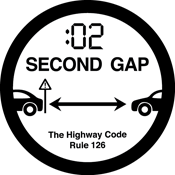
The faster you drive the less time you have to stop if something unexpected happens. Crashes happen when you run out of time and space.
Thinking distance is the distance travelled between the driver realising they need to brake and applying the brakes. It can be increased by tiredness, distractions, being under the influence of alcohol or other drugs and speed.
The braking distance is the distance taken to stop once the brakes are applied. It increases if the car’s brakes or tyres are in poor condition. Or the road and weather conditions are poor and with the cars speed.
The life saver
Your seatbelt could be a lifesaver. Did you know that you are twice as likely to die in a crash if you don’t wear one?
- Always wear your seatbelt and make sure your passengers are wearing theirs too.
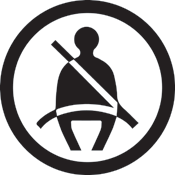
- It’s just as important to wear a seatbelt when travelling in the back - anyone or anything unrestrained in the car has the potential to kill or injure in a crash.
- Children under the age of 12 or 135cms tall (whichever is reached first) should always use the correct child seat or booster seat – this makes sure the seatbelt fits their smaller body.
The designated driver
Have you ever thought one drink won't matter it'll be fine? The only safe option is not to drink alcohol if you plan to drive.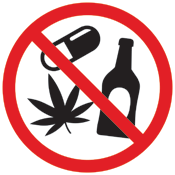
Even if you are below the legal limit, a small amount of alcohol will seriously alter your ability to drive. Reaction times may be slowed and judgement of risk, speed and distance may be impaired.
If you are intending to drink remove the question of driving from the equation. It’s not worth the risk.
How are you getting home?
- Booking a taxi? It can cost as little as one round of drinks.
- Catching the bus or train?
- Designating a driver? If you're in a group, agree who will be the designated driver before any alcohol has been drunk.
- Staying overnight?
- Walking home?
Mocktail and drive 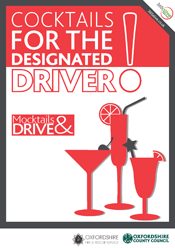
Mocktails are mock cocktails or non-alcoholic cocktails. They are a great alternative if you’re the designated driver or for party guests who are driving.
If you’re going out rather than staying at home, lots of restaurants, pubs and bars offer a Mocktail menu. If they don’t, you could ask for a ‘virgin’ version of your favourite cocktail instead, any drink recipe can be modified by simply leaving out the alcohol.
Download our mocktails leaflet for recipes you can enjoy and which will still let you drive.
The morning after
Enjoy a few beers or glasses of wine on a night out? Ever thought I've had a good night’s sleep I'll be fine to drive this morning?
You could still be over the drink drive limit the morning after, even if you feel fine.
If you’ve enjoyed a few alcoholic beverages last night make sure you’re not over the limit. Never drive if there’s even a slim chance you are still ‘under the influence’.
- Time is the only way to get alcohol out of your system.
- Drinking coffee, sleeping, or having a shower doesn’t work.
Use our handy guide to find out when you’ll be safe to drive after drinking or download our morning after leaflet.
Time for a break
We never fall asleep without warning. Drivers who fall asleep have often tried to fight off drowsiness by turning the heating to cold, opening a window or turning up the radio. These tactics don’t work.
It may be tempting to risk driving when tired, but it can be lethal. Research shows that it’s impossible to stop yourself eventually nodding off at the wheel.
Tips for long journeys
- Never start when tired.
- Include at least a 20-minute break every two hours.
- If possible share the driving on long journeys
- Get enough sleep and remember the same risks apply if you have to get up unusually early.
- Try to avoid long trips between midnight and 6am as we are more likely to feel sleepy during this period.
If you start to feel tired
- Find a safe place to stop, not the motorway hard-shoulder.
- Drink two cups of caffeinated coffee and have a rest for at least 15 to 20 minutes to give the caffeine time to kick in.
- Have a 20 power minute nap.
- When you feel alert again, drive on.
- Stopping for a nap and drinking a caffeinated drink only works once and is a temporary solution.
Speeding
49% of collisions occur whilst driving to, from or during work. How fast are you driving?
Are you up to speed with the consequences?
There are many different consequences you might face for speeding.
Generally, speeding carries a fixed penalty of £100 and three points on your driving licence. If you are within 7mph over the speed limit,you may be offered a 'Speed Awareness Course', which you pay for but will not receive points. You can only do one course in a three year period.
Over that, you will be offered a conditional offer of points and a fine, or be reported to go to court and - depending on the severity of the speed, which dictates the level of points - face disqualification and a fine.
Other consequences you may not be aware of include:
- Your car insurance could go up. You must declare all speeding offences within the last five years for most insurance companies, which will load your premium as you become higher risk
- You could be disqualified. This will have a huge impact on your personal and work life.
- You need to disclose any speeding convictions to your employer. Lying about this could be seen as fraud and lead to a further conviction.
- Getting a speeding ticket could be seen as gross misconduct by your employer and you could lose your job. Have you signed a policy with your company to say that you will not speed?

